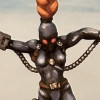

I mod a worryingly growing list of communities. Ask away if you have any questions or issues with any of the communities.
I also run the hobby and nerd interest website scratch-that.org.
This profile is from a federated server and may be incomplete. Browse more on the original instance.
The US Army experimented with digital camouflage as early as the 1970s. (lemmy.world)
militarytrader.com/…/dual-texture-gradient-camouf…
STRAC FAST, a magazine for your magazines (lemmy.world)
Album with a view of the spring.